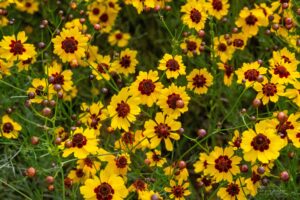Coreopsis flowers, commonly known as tickseed, are a delightful addition to any garden, renowned for their vibrant colors and prolific blooms. Belonging to the genus Coreopsis within the Asteraceae family, these charming perennials are native to North and South America, where they thrive in a variety of climates and soil conditions.
Characterized by their daisy-like appearance, Coreopsis flowers feature a prominent central disk surrounded by colorful ray florets. The ray florets, which can be yellow, orange, red, pink, or white, depending on the species and cultivar, create a cheerful display that attracts pollinators such as bees, butterflies, and other beneficial insects.
Coreopsis plants typically range from 1 to 3 feet (30 to 90 cm) in height, though some varieties may grow taller. The leaves of Coreopsis plants are typically opposite or alternate, simple, and often lance-shaped or lobed. The foliage may be green or gray-green in color, depending on the species and cultivar. Coreopsis stems are typically erect and branching, bearing multiple flower heads.

Each flower head consists of a central disk surrounded by colorful ray florets. The central disk contains numerous tiny tubular flowers, while the ray florets are petal-like and radiate outward from the center. Coreopsis flowers come in various colors, including shades of yellow, orange, red, pink, and white. The coloration may vary depending on the species and cultivar.
One of the most appealing qualities of Coreopsis flowers is their versatility. They are well-suited to a range of growing conditions, including full sun to partial shade and various soil types, from poor and dry to well-drained and fertile. This adaptability makes them excellent choices for gardens, borders, rockeries, wildflower meadows, and mixed perennial beds.
Coreopsis plants typically bloom from late spring to fall, producing an abundance of flowers that add a burst of color to the landscape. Deadheading spent flowers can encourage continuous blooming throughout the growing season, ensuring a prolonged display of beauty.
With their low-maintenance nature, Coreopsis flowers are ideal for both experienced and novice gardeners. Once established, they are drought-tolerant and have good resistance to pests and diseases. Regular watering and occasional fertilization can promote healthy growth and enhance flowering.
Cultivars of Coreopsis Flower
Coreopsis, also known as tickseed, encompasses numerous species and cultivars, offering a wide range of flower colors, sizes, and growth habits. Here are some popular cultivars of Coreopsis:
Coreopsis grandiflora ‘Sunray’: This cultivar features bright yellow flowers with a darker yellow center. It has a compact growth habit and blooms prolifically throughout the summer.
Coreopsis verticillata ‘Moonbeam’: ‘Moonbeam’ is a popular cultivar known for its delicate, fern-like foliage and soft, buttery-yellow flowers. It has a long blooming period and is excellent for borders or rock gardens.
Coreopsis ‘Zagreb’: ‘Zagreb’ is a compact cultivar with fine, thread-like foliage and bright yellow, daisy-like flowers. It blooms profusely from late spring to early fall and is perfect for containers or small spaces.
Coreopsis tinctoria ‘Plains Coreopsis’: This species is native to North America and is cultivated for its bright red and yellow bicolor flowers. It has a wildflower-like appearance and is often used in meadow or prairie gardens.
Coreopsis grandiflora ‘Presto’: ‘Presto’ is a dwarf cultivar with large, golden-yellow flowers and a compact, mounding growth habit. It blooms heavily in early summer and is well-suited for containers or small gardens.
Coreopsis ‘Limerock Ruby’: This cultivar stands out for its striking ruby-red flowers with a contrasting yellow center. It has a compact, bushy growth habit and blooms from late spring to early fall.
Coreopsis ‘Jethro Tull’: Named after the inventor of the seed drill, ‘Jethro Tull’ features unique, double yellow flowers with a fringed, ruffled appearance. It adds texture and interest to garden borders or mixed plantings.
These are just a few examples of the diverse range of Coreopsis cultivars available to gardeners. Whether you’re looking for vibrant colors, compact growth, or extended blooming periods, there’s likely a Coreopsis cultivar to suit your garden needs.
Sunlight Requirement of Coreopsis Flowers
Coreopsis flowers thrive in full sun, where they can receive 6 to 8 hours of direct sunlight daily. However, they can also tolerate partial shade, although their growth and flowering may be somewhat diminished under these conditions. Providing the appropriate sunlight exposure, along with well-drained soil and proper care, ensures healthy and vibrant Coreopsis plants in the garden.
Temperature and Humidity Requirements of Coreopsis Flower
Coreopsis flowers thrive in moderate temperatures. They generally prefer daytime temperatures between 60°F to 75°F (15°C to 24°C). These temperatures are optimal for robust growth, abundant flowering, and overall plant health. Different species and cultivars of Coreopsis have varying cold and heat tolerances. Most Coreopsis species are hardy in USDA Hardiness Zones 4-9, though specific cultivars may have different temperature preferences. It’s essential to select cultivars suitable for your region’s climate to ensure their long-term success in the garden.
Coreopsis plants can tolerate heat well, especially when provided with adequate moisture. However, in regions with hot summers, providing some afternoon shade or mulching around the base of the plants can help protect them from excessive heat stress and conserve soil moisture. Coreopsis flowers are generally adaptable to a wide range of humidity levels. They can tolerate both dry and humid conditions, making them versatile options for various climates and garden settings.

Soil Requirement of Coreopsis
Coreopsis flowers are generally adaptable to a wide range of soil types, but they thrive best in well-drained soil with moderate fertility. Sandy loam or loamy soil types are ideal for Coreopsis, as they allow water to drain freely while retaining some moisture. Coreopsis plants prefer slightly acidic to neutral soil pH levels ranging from 6.0 to 7.0.
Propagation of Coreopsis
Propagation of Coreopsis flowers through seed sowing is a simple and rewarding method. Here’s a step-by-step guide on how to do it:
Start by selecting healthy, high-quality seeds from a reputable source. You can also collect seeds from mature Coreopsis plants in your garden if available.
Plan to sow Coreopsis seeds in the spring after the last frost date in your area. This timing allows the seeds to germinate and establish before the growing season.
Choose a sunny location with well-drained soil. Coreopsis thrives in full sun but can tolerate some partial shade.
Loosen the soil to a depth of about 6-8 inches (15-20 cm) using a garden fork or tiller. Remove any weeds, rocks, or debris from the area.
Scatter the Coreopsis seeds evenly over the prepared seed bed. You can broadcast the seeds by hand or use a seed spreader for more even distribution.
Lightly press the seeds into the soil surface using the back of a rake or your hands. Avoid burying the seeds too deeply, as they require light to germinate.
Gently water the seeded area using a fine mist or a watering can with a rose attachment. Keep the soil evenly moist but not waterlogged.
Continue to water the seed bed regularly, especially during dry periods, to ensure optimal germination and seedling establishment.
Coreopsis seeds typically germinate within 1-3 weeks under favorable conditions. Be patient and continue to provide adequate moisture and sunlight.
As the seedlings emerge and grow, thin them out if they appear overcrowded. Aim for spacing of 12-18 inches (30-45 cm) between plants to allow for proper airflow and growth.
If you started seeds indoors or in seed trays, transplant the seedlings into their final growing location once they have developed several sets of true leaves.
Carefully dig a hole large enough to accommodate the root system of each seedling, then gently plant them at the same depth as they were in the seed trays.
Water the transplanted seedlings thoroughly to help them establish in their new location.
Once established, Coreopsis plants require minimal maintenance. Water them during dry spells, and provide support if needed for taller varieties.
By following these steps, you can successfully propagate Coreopsis flowers through seed sowing and enjoy their cheerful blooms in your garden.
Water Requirement of Coreopsis
When initially planting Coreopsis, it’s essential to keep the soil consistently moist but not waterlogged. This helps the plants establish a strong root system. Water deeply immediately after planting and continue to provide regular watering until the plants become established, usually during the first growing season. Once Coreopsis plants are established, they tend to be fairly drought-tolerant. However, they still benefit from regular watering during dry spells, especially if grown in sandy or fast-draining soils.
Fertilizer Requirement of Coreopsis Flowers
Coreopsis flowers generally have low to moderate fertilizer requirements. These plants are known for their adaptability and can thrive in relatively poor soils. However, providing some fertilizer can help promote healthy growth and abundant flowering. Coreopsis plants generally respond well to a balanced, all-purpose fertilizer with an equal ratio.
Problems While Growing Coreopsis Flowers
While Coreopsis flowers are generally easy to grow and relatively low-maintenance, they can still face some common problems. Here are a few issues you might encounter while growing Coreopsis and some tips for addressing them:
Overwatering: Coreopsis plants are susceptible to root rot if the soil remains consistently waterlogged. To prevent this problem, ensure that the soil has good drainage and avoid overwatering. Allow the soil to dry out slightly between waterings, especially during periods of cool, wet weather.
Pests: Common pests that may affect Coreopsis plants include aphids, spider mites, and thrips. These pests can cause damage to foliage, stunt growth, and reduce flowering. Monitor your plants regularly for signs of pest infestation, such as distorted leaves, stippling, or the presence of tiny insects. If pests are detected, you can try using insecticidal soap, neem oil, or other organic insecticides to control them.
Diseases: Coreopsis plants are generally resistant to most diseases, but they can occasionally be affected by fungal infections such as powdery mildew or root rot. To minimize the risk of disease, avoid overhead watering, which can promote fungal growth, and ensure good air circulation around the plants. Remove and dispose of any infected plant material promptly to prevent the spread of disease.
By addressing these common problems and providing proper care, you can help ensure that your Coreopsis plants thrive and produce an abundance of colorful flowers throughout the growing season.

Ornamental Uses of Coreopsis Flowers
Coreopsis flowers are valued for their ornamental qualities and are commonly used in various landscaping and garden design applications. Here are some ornamental uses of Coreopsis flowers:
Borders and edging: Coreopsis plants, with their low-growing and spreading habit, make excellent border plants along garden beds, pathways, or borders. Their profusion of colorful flowers adds visual interest and a cheerful ambiance to garden borders.
Rock gardens: Many species of Coreopsis, particularly those with compact growth habits, are well-suited for rock gardens. Their small size, vibrant flowers, and ability to thrive in dry conditions make them ideal candidates for rockery plantings.
Mass plantings: Coreopsis flowers are often used in mass plantings to create bold swaths of color in landscape beds or meadow-like settings. Planting large drifts or clusters of Coreopsis can create stunning visual impact, especially when combined with other complementary flowering perennials.
Container gardens: Compact varieties of Coreopsis, such as dwarf cultivars or those with trailing habits, are well-suited for container gardening. They can be planted in containers or hanging baskets to add a pop of color to patios, balconies, or outdoor living spaces.
Pollinator gardens: Coreopsis flowers are rich in nectar and attract a variety of pollinators, including bees, butterflies, and hummingbirds. Planting Coreopsis in pollinator gardens or butterfly gardens helps support local pollinator populations and adds ecological value to the landscape.
Cut flowers: Coreopsis flowers make excellent cut flowers for floral arrangements and bouquets. Their long stems and cheerful blooms add a vibrant touch to flower arrangements, and they can be combined with other garden flowers for a fresh-from-the-garden look.
Naturalized areas: Some species of Coreopsis, particularly native varieties, are well-suited for naturalized or wildflower meadow plantings. They can be used to create low-maintenance, wildlife-friendly habitats that require minimal care and provide seasonal interest with their colorful blooms.
Overall, Coreopsis flowers are versatile and adaptable plants that can be used in a variety of ornamental settings, from formal gardens to more naturalistic landscapes. With their long blooming period, vibrant colors, and easy-care nature, Coreopsis adds beauty and charm to any garden or landscape design.


